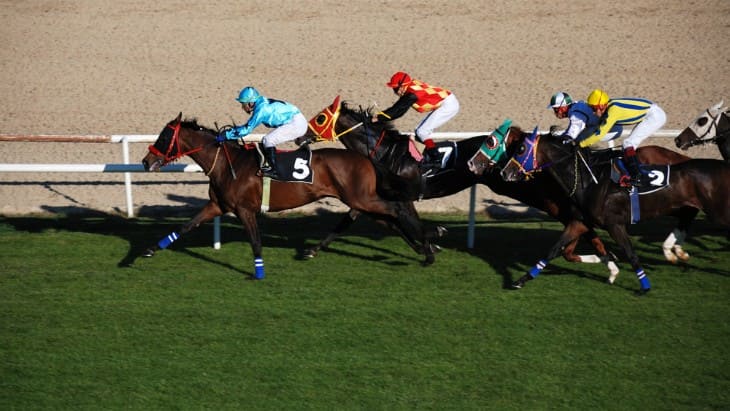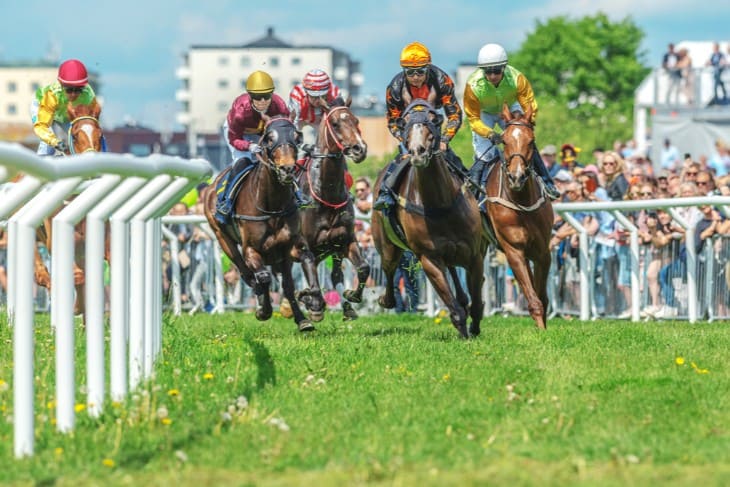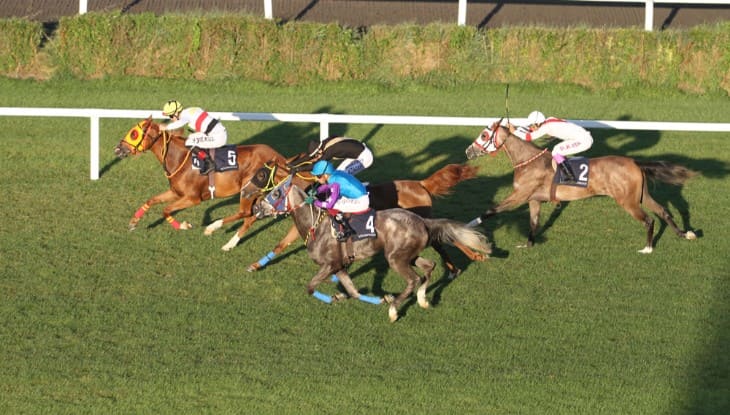William Lynn, a hotel owner who envisioned staging an enormous horse racing occasion, was behind establishing Aintree Racecourse. It started with the first race in 1839, shaping it into one of the most prestigious tracks on this planet. The beginning years of Aintree were marked by spirit and increased as racing fans began to value it.
The history of the racecourse has been shaped in a significant way by the development of its flagship race- The Grand National. Initially, it faced various challenges, such as financial difficulties and suspensions due to global happenings like wars. However, Aintree struggled through and eventually became a national treasure concerning the evolution of Grand National within its walls, which not only kept horses and jockeys busy in an actual sense but also fascinated many people's minds, leading to its historical significance over time.
The Grand National: Highlight Event
Aintree Racecourse is centered around the Grand National, often regarded as horse racing's ultimate challenge. This steeplechase tends to be demanding because it offers more distance and bigger fences than other contests. Critical facets include:
- Distance and Duration: It involves running about four miles plus 514 yards, making it among the longest races globally.
- Fences: There are thirty fences over two rounds, some notable ones being Becher's Brook or The Chair for their level of difficulty.
- Participation: Being an international competition among racers from different countries with various backgrounds, Aintree must exude prestige to foster large-scale attendance.
- Public Engagement: This event attracts millions across six continents when considering viewership and also introduces betting activity on horses into homes worldwide, indicating that its influence goes beyond the sports sphere itself.
The History Of The Grand National
Grand National instantly comes to mind when anyone mentions Aintree Racecourse since many consider it to be 'the ultimate test of horse and rider.' It is a steeplechase race characterized by its tedious nature, involving more distance to cover and bigger fences than regular races. The Grand National includes:
- Distance: The track is 4 miles plus 514 yards, making it one of the longest in the world.
- Fences: There are thirty fences for every two circuits; some, like Becher's and Chair's, have become notorious due to their toughness.
- Entry: This race attracts participants from all over the globe, both locally and internationally, signifying that it is highly regarded within the racing society.
- Publicity: One may wonder why this national horse racing event attracts millions from all across the globe. Although its effects go beyond the sporting arena, one cannot deny that the Grand National has a huge following of viewers amongst betters internationally.
Grand National's history abounds with unforgettable moments and remarkable achievements, making Aintree even more magnetic and legendary. It is also an event that tests for physical fitness and keeps an entire tradition alive since it stands as a symbol of endurance, supremacy, and quality in the thoroughbred universe today.
Track Design & Layout: An Elaborate Overview
Aintree Racecourse Features comprises its unique layout, making it an outstanding course. As regards its configuration, Aintree Racecourse Styles should be highlighted because they set it apart from any other course. The course at Aintree is known for being intricate and challenging for riders and horses.
More particularly, the Grand National course is infamous for its distances and diversity of obstacles; each fence possesses a distinct character and set of challenges. e.g., the size of Becher's Brook or the difficulty posed by the canal turn while successfully leading it through.
The circuit design has changed, with safety measures introduced to smooth race-running. The track is triangular, including both the Grand National Course and the Mildmay Course. Used in other National Hunt races, the Mildmay course features smaller and uniform fences. This diversity enables Aintree to give comprehensive tests of jumping and stamina that can suit different categories of horses.

Facilities and Services for the Spectators
The spectator experience at Aintree is one of its main selling points. The racecourse provides several facilities to ensure that visitors have an enjoyable time. These include:
- Viewing Areas: Spectators can choose various viewing areas, including grandstands that afford panoramic views across the track and more intimate settings around specific fences.
- Hospitality Services: Aintree offers a range of hospitality options, from exclusive packages in private suites to less formal dining experiences catering to different tastes and budgets.
- Accessibility: The racecourse possesses facilities that guarantee access to all visitors, including those with impairments.
- Transport and Parking: Aintree is well served by public transport and has ample parking, making it accessible to both local residents and visiting spectators.
In addition to racing, Aintree hosts various events throughout the year, such as concerts and exhibitions, thus underlining its versatility. Everything from well-maintained facilities to numerous options available for guests shows how serious this racecourse is about giving spectators the most enjoyable time possible. This commitment towards excellent spectator services goes a long way in defining the good reputation enjoyed by Aintree Racecourse.
The importance placed on safety measures and animal welfare has been one of the salient features of the Aintree Racecourse Features. The welfare of horses and jockeys is paramount; therefore, over time, this race course put strict measures into place to improve security. They encompass remodeling the jumps, intense medical check-ups for horses participating in races, and hard-set instructions for trainers or riders. For instance, changes made to fences have played a role in minimizing injuries, such as using softer materials or altering dimensions to encourage safer jumps altogether.
Furthermore, Aintree Racecourse has invested in cutting-edge healthcare facilities for humans and horses participating in racing events here. Onsite veterinary services and advanced medics are ready to provide immediate attention when required within these premises. In addition, specific protocols are established according to emergencies so that response can be done quickly without delays. This move towards safety demonstrates more significant concern about the wellbeing of animals in the horse racing industry.
Training and Preparation: Behind the Scenes
Training and preparation for events at Aintree Racecourse are very detailed and require high expertise. Trainers, jockeys, and horses undergo rigorous preparation regimes to ensure peak performance. Essential aspects of this preparation include:
- Physical Training: Horses participate in specialized training programs to improve their stamina and jumping capabilities. These programs are supported by those explicitly designed for jockeys, which involve physical fitness and strategy development.
- Diet and Nutrition: Nutritionists apply proper dietary provisions that supply essential food components for building horse strength and endurance.
- Track Familiarisation: Both horses and jockeys familiarize themselves with the Aintree Racecourse Features by spending time here, mainly because of the various fences peculiar to this track.
- Mental Preparation: An essential aspect of this is having mental toughness. Jockeys mainly engage in mental preparation for dealing with highly competitive races.
This comprehensive approach to training and preparation is crucial for success at Aintree. Due to its challenging nature, the course requires optimal readiness, making behind-the-scenes efforts as vital as race-day performances.

Media Coverage and Broadcasting Rights
To globalize Aintree Racecourse, media coverage, and licensing offers should be effectively used. Grand National Runner attracts immense media attention and many television viewers from all over the world. In addition, these concerns are addressed by television channels and internet platforms, where they are broadcast live to a worldwide audience. Hence, these rights concerning broadcasting bring in a lot of money for Aintree.
The significance of digital media in promoting Aintree Racecourse has increased dramatically. Social Media is one way this happens; for example, Twitter or Instagram offers real-time updates on races and behind-the-scenes insights while interacting with fans. However, web-based platforms such as social networks have opened access to live streaming, race updates, and other interactive stuff, thus widening its appeal to tech-savvy consumers. Traditional and digital media work together to keep Aintree's position in national and global horse racing.
The Global Reach of Aintree in Horse Racing
Aintree Racecourse is a global force that influences the world of horse racing, not just confined to the UK. This prestigious race, regarded as one of the most grueling and esteemed races around the globe, attracts international participation and interest. The acknowledgment of this racecourse globally is a testament to its unrepeatable appeal that has stood the test of time.
Also, the racecourse has influenced horse racing standards throughout the world. Other courses worldwide have adopted practices established at Aintree on factors like course layout, safety procedures, and race administration. Additionally, it has prompted similar events in other countries, thus contributing to the growth and development of this sport internationally. This means that Aintree Racecourse's power goes far beyond its boundaries, as it is known all over the world for its history and tradition and also for being an extraordinary challenge to top racers worldwide.
Conclusion
A bright future awaits Aintree Racecourse as it adjusts to changing trends in horse racing and society. Management focuses on adhering to heritage while introducing modernization into this venue. This includes investing in modern amenities, improving comfort levels for spectators, and furthering protective measures geared towards horses' wellbeing, both on track during races and after they finish them. These elements will always be observed to keep pace with the times.
In anticipation of what lies ahead for Aintree Racecourse, there are new challenges: adapting to technological advancements and responding to environmental issues. Nonetheless, given its ability to preserve its unique features, such as Aintree Course Features and traditions, while changing with times, it is well placed for continued success in the future.
Thus, the enduring appeal of events like Grand National and Aintree's status as a leading international horse racing venue guarantee that this will maintain a high profile even in the coming years. Henceforward, what happens next at Aintree Racecourse depends upon maintaining an equilibrium between traditionalism and innovation. It offers a thrilling racing experience but also adapts to the demands of a changing world.








